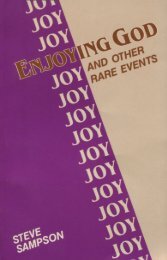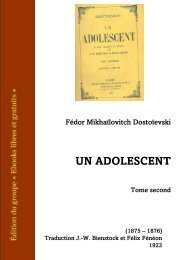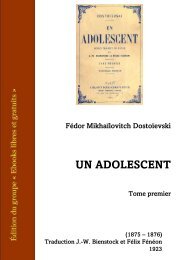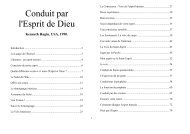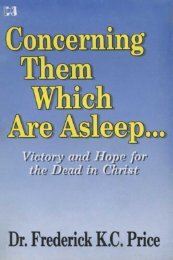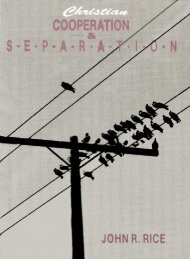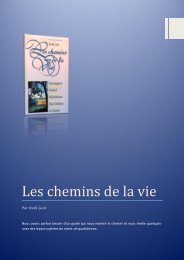Women writing in contemporary France
You also want an ePaper? Increase the reach of your titles
YUMPU automatically turns print PDFs into web optimized ePapers that Google loves.
13 MARGARET-ANNE HUTTON<br />
‘Il n’y a pas de troisième voie’ (There is<br />
no third way): Sylvie Germa<strong>in</strong> and the<br />
generic problems of the Christian novel<br />
Sylvie Germa<strong>in</strong> (1954–) is an unusual phenomenon on the French literary<br />
scene. Hav<strong>in</strong>g studied philosophy at the Sorbonne, she entered the audiovisual<br />
section of the M<strong>in</strong>istère de la culture <strong>in</strong> 1981, secur<strong>in</strong>g immediate literary<br />
success four years later with her first novel, Le Livre des nuits (1985). 1<br />
Establishment recognition was soon to be consolidated by the award of the<br />
prix Fém<strong>in</strong>a for her third novel, Jours de colère (1989). 2 S<strong>in</strong>ce then she has<br />
produced a steady output of texts: novels (set pr<strong>in</strong>cipally <strong>in</strong> either the<br />
French prov<strong>in</strong>ces or Prague, where she taught philosophy at the Ecole<br />
française from 1986, before return<strong>in</strong>g to <strong>France</strong> <strong>in</strong> 1992); shorter fictional<br />
works; explorations of religious faith articulated around strik<strong>in</strong>g commentaries<br />
based on both mystical and literary texts; works on Vermeer and on<br />
Holocaust diarist Etty Hillesum; and a venture <strong>in</strong>to children’s <strong>writ<strong>in</strong>g</strong>.<br />
Germa<strong>in</strong>’s work is characterised by a comb<strong>in</strong>ation of powerful lyricism and<br />
a lush proliferation of imagery, the deployment of an eclectic range of<br />
written and visual <strong>in</strong>tertexts, all set <strong>in</strong>to taut crystall<strong>in</strong>e structures. These<br />
are texts which cross boundaries, <strong>in</strong>tegrat<strong>in</strong>g myth and fable, <strong>in</strong>cursions<br />
<strong>in</strong>to the fantastic and an acute realism, a m<strong>in</strong>ute attention to visual detail.<br />
What s<strong>in</strong>gles Germa<strong>in</strong> out as a <strong>contemporary</strong> female writer, however,<br />
is the fact that her work is <strong>in</strong>formed by Christianity. More specifically, it<br />
reflects a self-confessed preoccupation with the existence of human suffer<strong>in</strong>g<br />
and evil (le mal) and their effect upon the wax<strong>in</strong>g and wan<strong>in</strong>g of religious<br />
faith. As she states: ‘Chez presque tous les créateurs, la vie ne tourne<br />
qu’autour d’un thème. Chez moi f<strong>in</strong>alement, il me semble que c’est le<br />
mal’ (For nearly all creators, life revolves around a s<strong>in</strong>gle theme, and <strong>in</strong> my<br />
case I’d say that theme is suffer<strong>in</strong>g/evil). 3 Germa<strong>in</strong>’s engagement with<br />
Christianity is unusual <strong>in</strong> a French female author; she follows <strong>in</strong> a predom-





